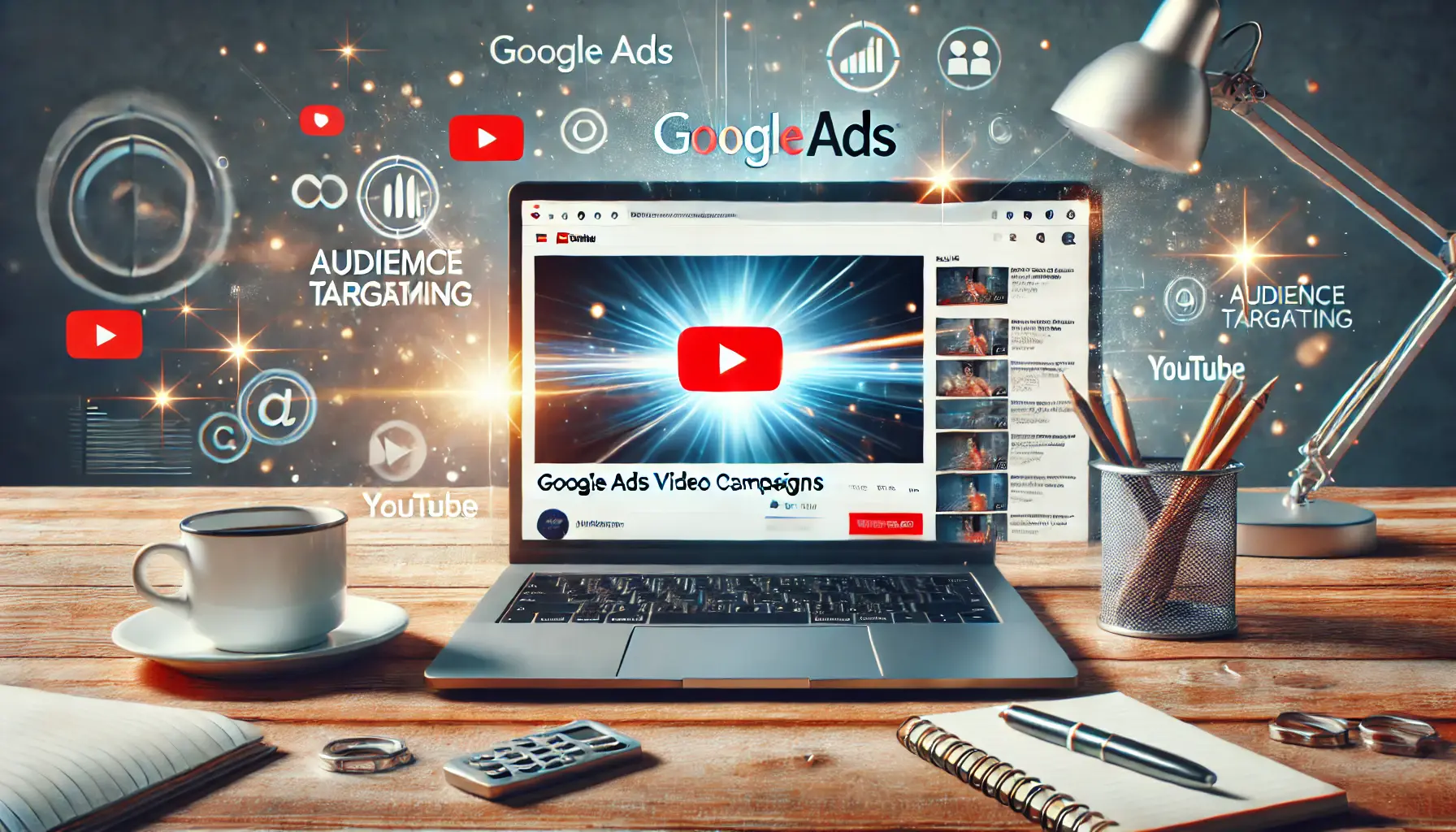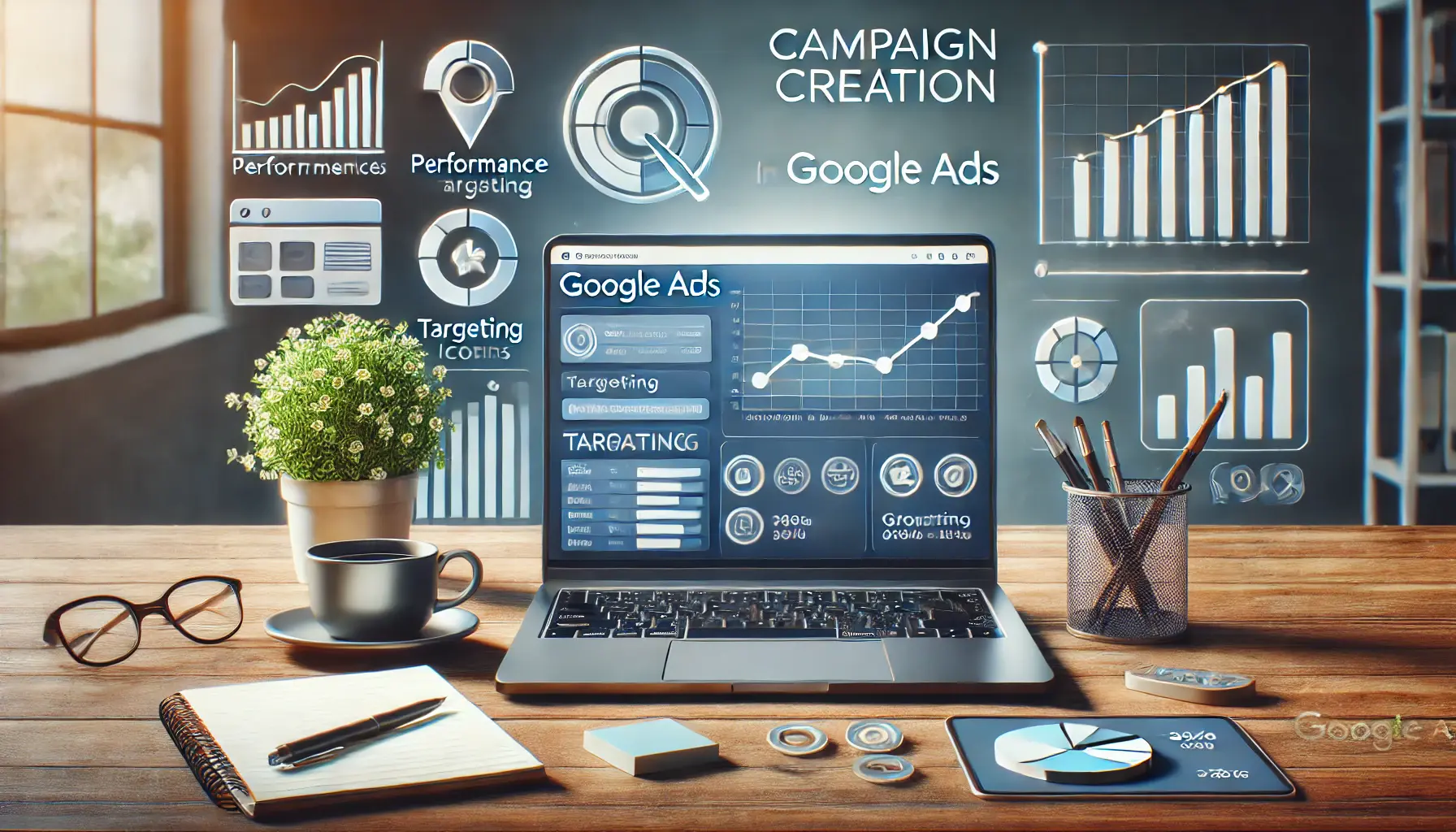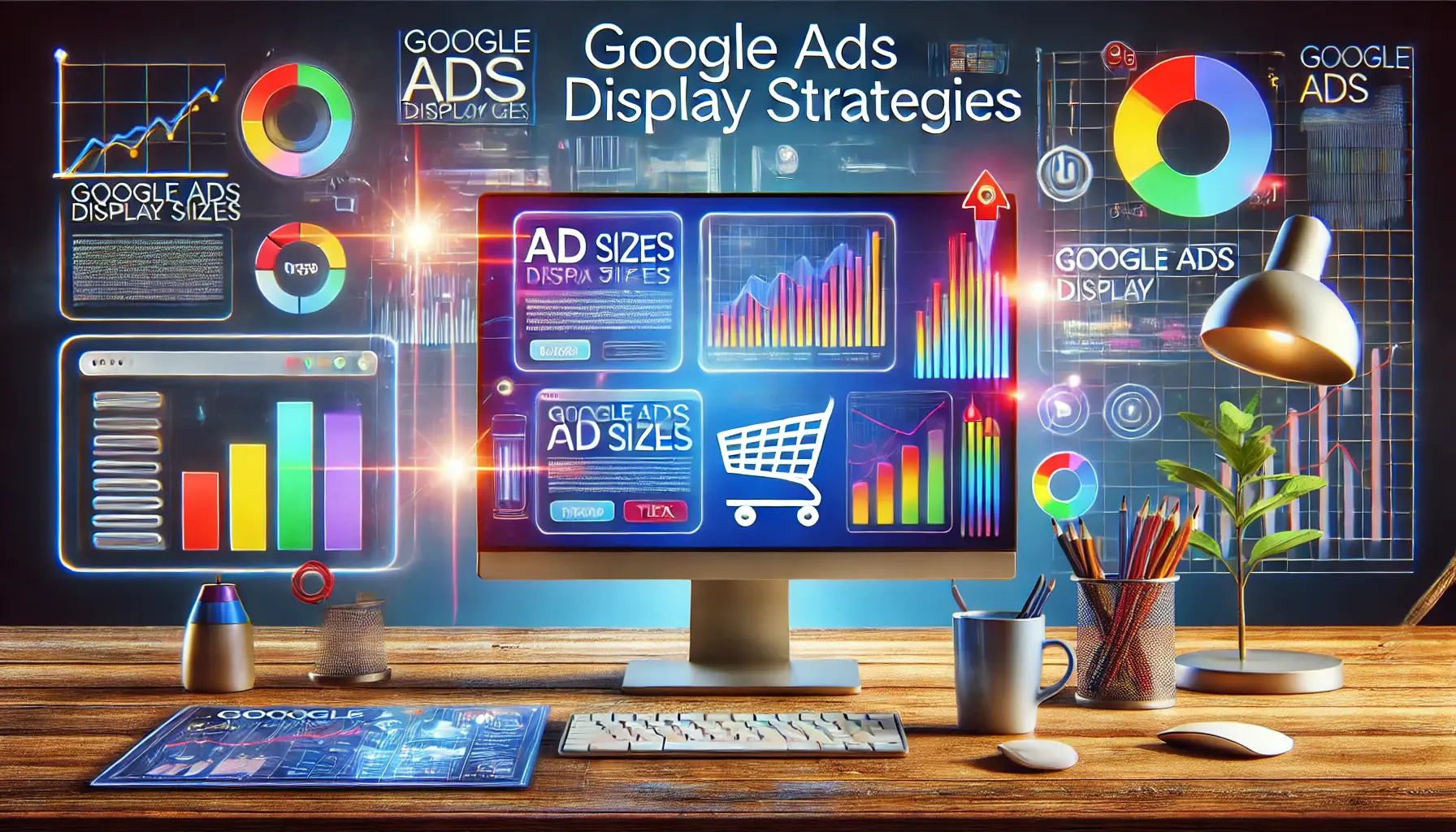Embarking on the journey of creating a successful Google Ads campaign can seem daunting, especially with the myriadA countless or extremely large number of options or possibilities. of options available.
However, understanding the various campaign types is a crucial first step in simplifying the process and ensuring your advertising efforts align with your business goals.
Let’s delve into the different Google Ads campaign types to help you make informed decisions.
- Understanding Google Ads Campaign Types
- Setting Clear Objectives for Your Campaign
- Structuring Your Google Ads Account Effectively
- Structuring Your Google Ads Account Effectively
- Structuring Your Google Ads Account Effectively
- Mastering Campaign Creation in Google Ads
- Frequently Asked Questions about Campaign Creation in Google Ads
Understanding Google Ads Campaign Types
Google Ads offers several campaign types, each designed to meet specific marketing objectives.
Choosing the right type is essential to effectively reach your target audience and achieve your desired outcomes.

A focused depiction of Google Ads Search Campaigns targeting active searchers.
Search Campaigns: Reaching Active Searchers
Search campaigns allow your ads to appear on Google’s search results pages when users search for keywords related to your products or services.
This campaign type is ideal for capturing the attention of potential customers actively seeking information or ready to make a purchase.
- Benefits: Targets high-intent users, increases website traffic, and boosts conversions.
- Ad Format: Text-based ads that appear alongside search results.

An illustrative depiction of Google Ads Display Campaigns showcasing their expansive reach.
Display Campaigns: Expanding Your Reach
Display campaigns involve showing your ads across the wide network of websites, apps, and Google-owned properties such as YouTube and Gmail.
It’s an effective way of reaching a wide audience and increasing brand awareness.
- Benefits: Broadens visibility, supports retargeting strategies, and uses visually engaging ad formats.
- Ad Format: Image and responsive ads that adapt to various placements.

A depiction of Google Ads Video Campaigns on YouTube, highlighting audience engagement.
Video Campaigns: Engaging Audiences on YouTube
Video campaigns enable you to present video ads on YouTube and other Google Display Network sites.
This format is excellent for storytelling and creating a deeper connection with your audience.
- Benefits: Enhances engagement through visual storytelling, reaches a vast audience, and supports various ad formats like skippable and non-skippable ads.
- Ad Format: Video ads displayed before, during, or after YouTube videos.

A depiction of Google Ads Shopping Campaigns showcasing retail product promotions.
Shopping Campaigns: Promoting Retail Products
Shopping campaigns are designed for retailers who want to promote their product inventory.
These campaigns appear in search results and the Google Shopping tab, providing users with detailed information about your products.
- Benefits: Showcases your product images and prices, captures high-intent shoppers, and drives online and in-store sales.
- Ad Format: Product listings containing images, titles, prices, and store names.

A depiction of Google Ads App Campaigns, focusing on driving app installs and mobile engagement.
App Campaigns: Driving App Installs
App campaigns drive app installs and in-app engagement across Search, Play, YouTube, Discover, and more than 3 million sites and apps.
The goal of this campaign type is to drive app installs or increase in-app engagement.
- Benefits: Simplifies ad creation, maximizes exposure for the app, and uses machine learning to continuously improve.
- Ad Format: Ads created from information and assets about your app.
Understanding these campaign types and the unique advantages each carries will empower you to create a Google Ads strategy that fits your business objectives while effectively reaching and capturing your target audience.
Embarking on a Google Ads campaign without clear objectives is like setting sail without a destination.
To navigate the vast digital marketing seas effectively, it’s essential to chart a course by setting precise goals.
This approach not only streamlines your campaign creation but also ensures your advertising efforts align seamlessly with your business aspirations.
Understanding the campaign types is fundamental for aligning your advertising goals with your business objectives effectively.

A scene representing the process of setting clear objectives for a successful campaign.
Setting Clear Objectives for Your Campaign
Setting up your campaign goals is a critical part of the campaign creation process.
These goals determine the campaign types, bidding methods, and performance metrics that measure the effectiveness of your advertising efforts.
When creating your campaign goals, consider the following:
- Sales: Drive sales or conversions online, in-app, by phone, or in-store. This objective targets customers who are at the bottom of the purchase funnel.
- Leads: Encourage relevant customers to take action by showing interest in a product or service through newsletter subscriptions or sharing their contact information.
- Website Traffic: Drive more people to your website, increasing the chances of conversions.
- Brand Awareness and Reach: Make as many people as possible aware of your products or services.
- App Promotion: Increase installs, in-app engagement, and pre-registrations for your mobile application.
- Local Store Visits and Promotions: Drive foot traffic to physical stores and promote local offers.
Aligning your campaign objectives with your business goals is crucial.
For instance, if you’re launching a new product, focusing on brand awareness might be more appropriate, whereas driving sales would be the priority for an e-commerce store during a holiday promotion.
Remember, clear and measurable objectives not only guide your advertising strategies but also facilitate evaluating your performance over time.
By investing time in strategic planning, you set your Google Ads campaigns up for long-term success.
Embarking on the journey of campaign creation in Google Ads requires a well-structured account to ensure efficiency and effectiveness.
A thoughtfully organized account not only streamlines management but also enhances performance, leading to better results for your advertising efforts.
Clear and measurable objectives ensure that your advertising strategy is targeted and results-oriented.

A representation of the structured organization required for managing a Google Ads account effectively.
Structuring Your Google Ads Account Effectively
Creating a logical and organized account structure is essential for successful campaign creation in Google Ads.
A well-structured account allows for precise targeting, efficient budget allocation, and easier optimization, ultimately leading to improved performance.

A depiction of the organization process for Google Ads campaigns and ad groups.
Organizing Campaigns and Ad Groups
Align your campaigns with your business objectives and product or service offerings.
Each campaign should focus on a single goal, such as increasing website traffic or driving sales.
Within each campaign, create ad groups centered on closely related keywords and themes.
This approach ensures relevance between the target search queries and the ads, improving Quality Score and ad performance.
- Campaign Level: Establish overall budgets and targeting options aligned with your marketing goals.
- Ad Group Level: Segment similar keywords into groups to create highly relevant ads for each group.

A depiction of the keyword research process for Google Ads, emphasizing data analysis and keyword selection.
Conducting Thorough Keyword Research
Effective keyword research is a cornerstone of building successful campaigns.
Utilize tools like Google’s Keyword Planner to identify relevant keywords that your target audience is searching for.
Focus on a mix of broad and long-tail keywords to capture a wide range of search intent.
Regularly update and refine your keyword list to adapt to changing market trends and consumer behavior.
- Find Relevant Keywords: Use keyword search tools to determine the terms your potential customers might use.
- Research Competitor Keywords: Investigate targeted keywords used by competitors to identify opportunities.
- Group Keywords by Theme: Segment keywords into thematic categories to enable the creation of highly targeted ads.

A depiction of the process of crafting compelling ad copy for Google Ads, highlighting creativity and audience engagement.
Crafting Compelling Ad Copy
Writing ad copy that is relevant and engaging is crucial for attracting clicks and conversions.
Ensure your ad copy aligns with the keywords in each ad group and addresses the needs of your target audience.
Highlight unique selling propositions and include clear calls to action to encourage users to take specific steps.
A/B testing different ad variations provides insights into what resonates best with your audience, enabling continuous improvement.
- Include Relevant Keywords: Incorporate relevant keywords into ad copy to enhance ad relevance and improve Quality Score.
- Highlight Unique Selling Points: Emphasize what sets your product or service apart from competitors.
- Use Clear Calls to Action: Encourage specific actions such as ‘Shop Now’ or ‘Learn More.’
Emphasizing these major focal points—campaign and ad group organization, comprehensive keyword research, and the creation of compelling ad copy—lays a solid foundation for creating effective campaigns in Google Ads.
This structured approach facilitates better performance, greater engagement, and the attainment of your advertising goals.
Embarking on the journey of campaign creation in Google Ads requires a well-structured account to ensure efficiency and effectiveness.
A thoughtfully organized account not only streamlines management but also enhances performance, leading to better results for your advertising efforts.
A well-structured account improves targeting precision and simplifies budget allocation, leading to better campaign performance.

A representation of structuring a Google Ads account effectively, with a focus on organization and hierarchy.
Structuring Your Google Ads Account Effectively
Creating a logical and organized account structure is essential for successful campaign creation in Google Ads.
A well-structured account allows for precise targeting, efficient budget allocation, and easier optimization, ultimately leading to improved performance.

A representation of the process of organizing Google Ads campaigns and ad groups for efficient management.
Organizing Campaigns and Ad Groups
Align your campaigns with your business objectives and product or service offerings.
Each campaign should be set up to achieve just one goal, such as driving website traffic or generating sales.
Within each campaign, ad groups should be built around tightly knit groups of keywords and themes.
This ensures relevance between the targeted search queries and the ads, which is vital for Quality Score and ad performance.
- Campaign Level: Establish overall budgets and targeting options that align with your marketing goals.
- Ad Group Level: Segment similar keywords into groups to create highly relevant ads for each group.

A depiction of conducting thorough keyword research for Google Ads, emphasizing data analysis and keyword selection.
Conducting Thorough Keyword Research
Effective keyword research is integral to campaign building.
Utilize free tools like Google Keyword Planner to identify keywords that align with the search behaviors of your target audience.
Ensure a mix of broad and long-tail keywords to capture significant variations in search intent.
Continuously update and refine your list to adapt dynamically to shifting market trends and consumer behavior.
- Find Relevant Keywords: Use keyword search tools to uncover terms your prospective customers may be using.
- Research Competitor Keywords: Analyze targeted keywords used by competitors to uncover opportunities.
- Group Keywords by Theme: Categorize keywords into thematic groupings to enable the creation of highly targeted ads.

A representation of the process of writing effective ad copy for Google Ads, emphasizing creativity and audience engagement.
How to Write Ad Copy That Works
Writing relevant and engaging ad copy is crucial to ensure clicks and conversions.
Ensure your ad copy fits the keywords in each ad group and addresses the needs of your target audience.
Highlight unique selling propositions and include clear calls to action that detail what the user should do next.
A/B testing different ad creatives provides valuable insights into what resonates best with your audience, enabling continuous improvement.
- Use Relevant Keywords: Include relevant keywords in ad copy to improve ad relevance and increase Quality Score.
- Highlight Unique Selling Points: Mention what makes your product or service unique from others.
- Use Clear Calls to Action: Examples include ‘Shop Now’ and ‘Learn More.’
Emphasizing major focal points such as the organization of campaigns and ad groups, thorough keyword research, and the creation of captivating ad copy lays a strong foundation for building powerful campaigns in Google Ads.
This structured approach facilitates better campaign performance, higher engagement, and the attainment of advertising goals.
Embarking on the journey of campaign creation in Google Ads requires a well-structured account to ensure efficiency and effectiveness.
A thoughtfully organized account not only streamlines management but also enhances performance, leading to better results for your advertising efforts.

A representation of structuring a Google Ads account effectively, with organized campaigns and ad groups.
Structuring Your Google Ads Account Effectively
Creating a logical and organized account structure is essential for successful campaign creation in Google Ads.
A well-structured account allows for precise targeting, efficient budget allocation, and easier optimization, ultimately leading to improved performance.

A representation of the process of organizing Google Ads campaigns and ad groups for effective management.
Organizing Campaigns and Ad Groups
Align your campaigns with your business objectives and product or service offerings.
Each campaign should be set up to achieve just one goal, such as driving website traffic or generating sales.
Within each campaign, ad groups must be built around tightly knit groups of keywords and themes.
This ensures relevance between the targeted search queries and the ads, which is important for Quality Score and ad performance.
- Campaign Level: Establish overall budgets and targeting options that align with your marketing goals.
- Ad Group Level: Segment similar keywords into groups to create highly relevant ads for each group.

A depiction of conducting thorough keyword research for Google Ads, emphasizing data analysis and keyword selection.
Conducting Thorough Keyword Research
Effective keyword research forms the basis of any successful campaign.
Utilize free tools, such as Google Keyword Planner, to identify ideal keywords in line with the target audience’s search behaviors.
Include a mix of broad and long-tail keywords to capture significant variations in search intent.
Continuously update and refine your list to adapt dynamically to shifting market trends and consumer behavior.
- Find Relevant Keywords: Employ keyword search tools to discover terms your probable customers may be using.
- Research Competitor Keywords: Analyze the targeted keywords used by competitors to uncover opportunities.
- Group Keywords by Theme: Organize keywords into thematic groupings to enable the creation of highly targeted ads.

A depiction of the process of writing compelling ad copy for Google Ads, highlighting creativity and audience engagement.
How to Write Ad Copy That Works
Writing relevant and engaging ad copy is crucial to ensure clicks and conversions.
Ensure that your ad copy fits the keywords in each ad group and addresses the needs of your target audience.
Highlight unique selling propositions and include clear calls to action that guide users on what to do next.
A/B testing different ad creatives provides valuable insights into what resonates best with your target audience, enabling continuous improvements.
- Relevant Keywords: Include relevant keywords in ad copy to improve ad relevance and Quality Score.
- Unique Selling Points: Mention what differentiates your product or service from others.
- Clear Calls to Action: Examples include ‘Shop Now’ and ‘Learn More.’
These focal points—organization and structuring of campaigns and ad groups, comprehensive keyword research, and crafting compelling ad copies—form the backbone of running powerful campaigns on Google Ads.
This approach ensures proper flow, higher campaign performance, improved engagement, and the accomplishment of advertising goals.

A representation of mastering the process of campaign creation in Google Ads, emphasizing detailed metrics and optimization.
Mastering Campaign Creation in Google Ads
Creating a successful campaign in Google Ads is a systematic process that requires attention to detail, strategic planning, and a clear understanding of your goals.
By following the best practices outlined in this article, you can optimize your advertising efforts and achieve remarkable results for your business.

A depiction of key takeaways for effective campaign creation, focusing on performance metrics and campaign optimization.
Key Takeaways for Effective Campaign Creation
Setting clear and measurable objectives is the first step in the journey of creating campaigns.
This aligns your goals with business needs and ensures a focused approach that yields tangible outcomes.
Each campaign type offers unique advantages, and selecting the right one is crucial for maximizing impact.
- Structured Organization: Create campaigns and ad groups that align with specific objectives to streamline management and enhance performance.
- Thorough Keyword Research: Utilize tools like Google Keyword Planner to identify relevant and high-performing keywords that resonate with your target audience.
- Compelling Ad Copy: Craft engaging and relevant ads that include clear calls to action and emphasize your unique selling propositions.

A depiction of achieving optimal performance in Google Ads campaigns through growth and successful optimization.
Achieving Optimal Performance
Maintaining an iterative process of performance monitoring and optimization ensures that campaigns perform at their best.
Regularly review performance metrics, conduct A/B testing, and refine strategies based on data insights.
This continuous improvement cycle keeps campaigns competitive in the dynamic digital advertising space.
Additionally, proper budget allocation and effective bidding strategies play a vital role in campaign success.
Balancing cost-efficiency with performance goals enables sustainable growth and a higher return on investment.

A depiction of the significance of campaign creation in Google Ads, emphasizing its impact on performance and growth.
Why Campaign Creation Matters
Creating a campaign in Google Ads today is more than just an aspect of marketing; it is a strategic investment.
A well-designed campaign not only secures increased site traffic and sales but also strengthens your brand’s online presence and customer relationships.
Whether it’s about acquiring leads, driving app installs, or selling products, the success of any ad campaign is built upon laying the right foundation.
By mastering the art of campaign creation in Google Ads, your business unlocks unparalleled opportunities to reach new heights, better target your audience, and achieve the desired results from your campaigns with precision.
Mastering campaign creation involves strategic planning, performance monitoring, and continuous optimization to achieve optimal results.

A representation of frequently asked questions about Google Ads campaign creation, symbolizing the process of addressing key queries.
Your campaigns can be managed by an agency specialized in Google Ads, check out our service page.
Frequently Asked Questions about Campaign Creation in Google Ads
Embarking on campaign creation in Google Ads often raises several questions.
Here are some common queries to guide you through the process.
Begin by setting clear, measurable objectives that align with your business goals to guide your campaign strategy effectively.
Select a campaign type—Search, Display, Video, Shopping, or App—based on your specific marketing objectives and target audience.
Keyword research identifies terms your potential customers use, enabling effective targeting and improved ad relevance.
Organize your account into campaigns and ad groups that reflect your business structure, products, or services for streamlined management.
Compelling ad copy is clear, relevant, includes strong calls to action, and highlights unique selling propositions to engage your audience.
Determine your daily or monthly budget based on your overall marketing budget, campaign goals, and the competitiveness of your industry.
Google Ads offers various bidding strategies, including manual CPC, enhanced CPC, and automated bidding options like Target CPACost Per Acquisition, a metric used in advertising to measure the cost of acquiring one customer or lead..
Utilize Google Ads’ analytics tools to monitor metrics such as clicks, impressionsThe number of times an ad is shown to users on a screen., CTRClick-Through Rate, a metric that measures the ratio of clicks to impressions in digital advertising., and conversions to assess campaign effectiveness.
Negative keywords prevent your ads from showing on irrelevant searches, improving targeting and reducing wasted spend.














